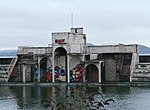Kents Bank railway station
1857 establishments in EnglandDfT Category F2 stationsFormer Ulverston and Lancaster Railway stationsGrange-over-SandsNorth West England railway station stubs ... and 7 more
Northern franchise railway stationsPages with no open date in Infobox stationRailway stations in CumbriaRailway stations in Great Britain closed in 1858Railway stations in Great Britain opened in 1857Railway stations in Great Britain opened in 1859Use British English from December 2017

Kents Bank is a railway station on the Furness Line, which runs between Barrow-in-Furness and Lancaster. The station, situated 17+1⁄4 miles (28 km) north-west of Lancaster, serves the village of Kents Bank in Cumbria. It is owned by Network Rail and managed by Northern Trains.
Excerpt from the Wikipedia article Kents Bank railway station (License: CC BY-SA 3.0, Authors, Images).Kents Bank railway station
Embankment Path,
Geographical coordinates (GPS) Address External links Nearby Places Show on map
Geographical coordinates (GPS)
| Latitude | Longitude |
|---|---|
| N 54.1728754 ° | E -2.9252051 ° |
Address
Kents Bank
Embankment Path
LA11 7BG
England, United Kingdom
Open on Google Maps









